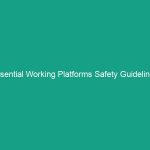Introduction
In today’s world, the importance of Health, Safety, and Environment (HSE) cannot be overstated. Organizations across various sectors are increasingly recognizing that effective emergency response coordination is vital for safeguarding their workforce, assets, and the environment. Emergencies can arise unexpectedly, and having a robust response strategy is crucial for minimizing risks and ensuring a swift recovery. This article delves into essential emergency response coordination guidelines that every organization should know to enhance Workplace Safety and compliance.
Regulatory Frameworks for Emergency Response Coordination
Understanding the regulatory landscape is fundamental for effective emergency response coordination. Various laws and Regulations govern Workplace Safety and emergency preparedness, including the Occupational Safety and Health Administration (OSHA) standards in the United States, the Health and Safety at Work Act in the UK, and the National Fire Protection Association (NFPA) guidelines. Compliance with these regulations not only helps organizations avoid legal repercussions but also fosters a culture of Safety.
Key Regulations to Consider
- osha Standards: OSHA mandates that employers must provide a safe workplace and have an Emergency Action Plan (EAP) in place.
- Environmental Protection Agency (EPA) Regulations: The EPA regulates hazardous substances and requires that organizations have spill response plans.
- NFPA Codes: The NFPA provides guidelines for fire safety and emergency response Procedures.
Importance of Compliance
Compliance with these regulations is not just about avoiding fines; it is about establishing a proactive approach to safety. Organizations that prioritize compliance are better positioned to manage emergencies effectively. This involves regular Training, drills, and updates to emergency response plans to align with current regulations. Moreover, compliance promotes a culture of safety, ensuring that employees are aware of their roles during an emergency.
Best Practices for Emergency Response Coordination
Implementing Best Practices in emergency response coordination can significantly enhance an organization’s ability to manage crises. These practices include developing a comprehensive emergency response plan, conducting regular drills, and fostering a culture of safety among employees.
Developing an Emergency Response Plan
An effective emergency response plan (ERP) serves as the blueprint for how an organization will respond to various emergencies. Key components of an ERP should include:
- Identification of Potential Emergencies: Analyze potential risks specific to your organization, such as Fires, chemical spills, or natural disasters.
- Clear Roles and Responsibilities: Assign specific roles to employees during an emergency to ensure a coordinated response.
- Communication Protocols: Establish clear communication channels to disseminate information quickly and effectively during a crisis.
Conducting Regular Drills and Training
Regular training and drills are essential for ensuring that employees are familiar with the emergency response plan. These exercises help identify gaps in the plan and allow for real-time practice of coordination efforts. Engaging employees in simulations can also boost their confidence and preparedness, making them more effective during actual emergencies.
Fostering a Culture of Safety
Creating a culture of safety within the workplace encourages employees to take personal responsibility for safety and emergency preparedness. This can be achieved through ongoing education, open communication about safety concerns, and recognition of Safe Practices. When employees feel empowered to contribute to safety initiatives, they are more likely to engage in proactive behaviors that enhance emergency response coordination.
Case Studies: Successful Emergency Response Coordination
Examining real-world case studies can provide invaluable insights into effective emergency response coordination. Here, we highlight a few organizations that have successfully implemented robust emergency response strategies.
Case Study 1: ABC Manufacturing
ABC Manufacturing faced a significant risk of chemical spills due to the nature of its operations. To mitigate this risk, the company developed a comprehensive emergency response plan that included regular training and collaboration with local emergency services. Their proactive approach paid off when a minor chemical spill occurred. Employees followed the established protocols, and the situation was contained quickly with minimal impact.
Case Study 2: XYZ Construction
XYZ Construction implemented an emergency response coordination strategy that involved daily safety briefings and scenario-based training exercises. During a severe thunderstorm, the crew was able to evacuate the site efficiently due to their preparedness. The company’s focus on training and communication allowed them to manage the situation effectively, ensuring the safety of all personnel.
Challenges in Emergency Response Coordination
While many organizations strive for effective emergency response coordination, several challenges can impede their efforts. Recognizing these challenges is the first step toward overcoming them.
Common Challenges
- Lack of Resources: Many organizations struggle with limited budgets for training and emergency preparedness. Allocating resources effectively is crucial for developing a strong emergency response plan.
- Employee Engagement: Ensuring that all employees are engaged and well-informed about emergency protocols can be challenging, especially in larger organizations.
- Changing Regulations: Keeping up with evolving regulations and standards can be daunting, requiring continuous updates to emergency response plans.
Strategies to Overcome Challenges
To address these challenges, organizations can implement several strategies:
- Integrate Emergency Response into Company Culture: Make safety a core value and part of the organizational culture, encouraging all employees to participate in safety initiatives.
- Utilize Technology: Leverage technology to facilitate training, communication, and coordination during emergencies, such as using mobile apps for real-time updates.
- Regular Review and Update of Plans: Set a schedule for regular reviews of emergency response plans to ensure they remain compliant and relevant.
Future Trends in Emergency Response Coordination
The landscape of emergency response coordination is continuously evolving. As organizations become more aware of the importance of HSE, several trends are emerging that are shaping the future of emergency management.
Increased Use of Technology
Technology is playing an increasingly vital role in emergency response coordination. Tools such as drones for assessing disaster areas, mobile apps for real-time communication, and data analytics for risk assessment are becoming standard in emergency management. Organizations that adopt these technologies can enhance their preparedness and response capabilities significantly.
Focus on Mental Health in Emergency Preparedness
Recognizing the psychological impact of emergencies on employees is becoming a key aspect of emergency response coordination. Organizations are starting to include mental health support as part of their emergency preparedness plans, ensuring that employees have access to resources that help them cope with the stress and trauma associated with emergencies.
Collaboration with Local Emergency Services
Building strong relationships with local emergency services is crucial for effective emergency response coordination. Collaborative training exercises and clear communication channels can enhance the overall response efforts during an incident, ensuring a more organized and effective approach to emergencies.
Conclusion
In conclusion, effective emergency response coordination is essential for Workplace Safety and compliance with HSE regulations. By understanding regulatory frameworks, implementing Best Practices, learning from case studies, addressing challenges, and keeping abreast of future trends, organizations can significantly enhance their emergency preparedness and response capabilities. As you reflect on the guidelines presented in this article, consider evaluating your organization’s current emergency response strategies. Remember, a proactive approach can significantly mitigate risks and ensure the safety of your workforce. Take action today to strengthen your emergency response coordination efforts!


